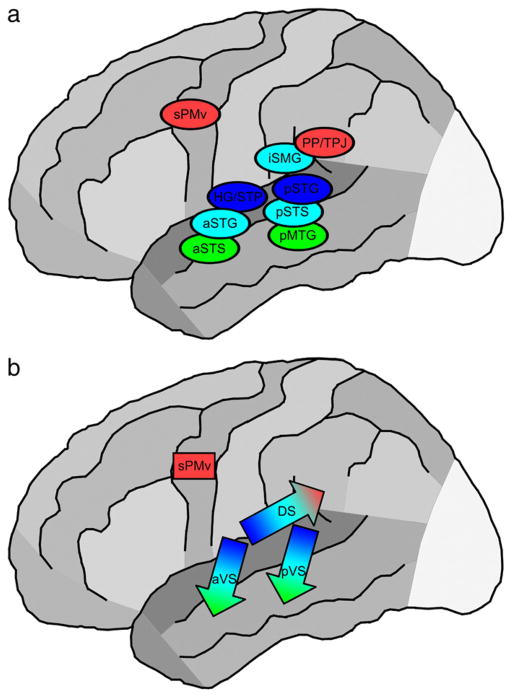Fig. 6.
Illustration of a “dual ventral stream” model for auditory speech processing, consistent with our results and prior studies (Crinion et al., 2003; Miglioretti and Boatman, 2003; Indefrey and Cutler, 2004; Scott and Wise, 2004). The model is identical to that of Hickok and Poeppel (2007) in the overall division between a dorsal stream (DS) and a ventral stream (VS). It additionally specifies that the ventral stream is often split topographically into two streams traversing the STG to the STS and MTG. The anterior ventral stream (aVS) proceeds ventro-laterally from Heschl’s gyrus (HG) and belt regions (Scott et al., 2000). The posterior VS (pVS) and the dorsal stream arise from the planum temporale (Griffiths and Warren, 2002). In some subjects the anterior and posterior ventral streams may overlap at the mid-STG, but the most common phenotype, and the pattern most likely obtained in a meta-analysis across patients, is a bimodal (dual stream) distribution. The colors in the figure roughly indicate function as acoustic–phonetic (blue), phonological (turquoise), and word-form/lexico-semantic (green). For the dorsal stream, red indicates involvement in speech production. Note that not all dorsal stream areas are labeled here (operculum, insula, etc.). The arrows with color gradients in b indicate that there are no sharp divisions between regions supporting these functional roles. Rather, the auditory processing becomes increasingly linguistic with progression along the ventral stream and increasingly WM- and response-related along the dorsal stream.

